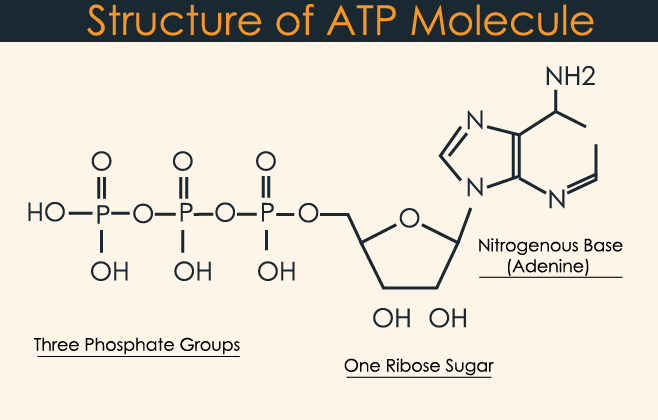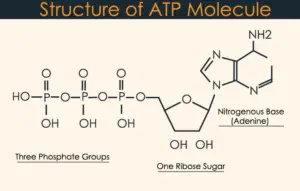
What is ATP ? Let’s Us Now Have a Closer Look At It.
ATP ( stands for adenosine triphosphate) is a source of energy and the basis of life. It involves in metabolic processes. It is a universal source of energy for all biochemical processes taking place in living systems, in particular for the formation of enzymes.
ATP is the primary energy source for most cellular processes. It releases more energy during hydrolysis and is the most direct source of energy in the organism. Since the energetic function of it is intimately connected to the catalytic function of enzymes, it is considered a coenzyme.
Structure
The particular ATP structure, specifically the two pyrophosphate bonds, make it an energy-rich compound. It is made up of a nitrogenous base, adenine. In the center of the molecule is the ribose. It is a pentose type of sugar since it has five carbon atoms. Three phosphate groups, alpha, beta, and gamma.

What is ATP in photosynthesis and in cellular respiration?
In photosynthesis, ATP is a first stage product and energy carrying substance. It produces via solar energy and transforms it into organic fuel. The energy used for vital processes is the chemical energy that is freed from the breakdown of the chemical bonds between the atoms that form particular organic molecules.
Moreover, it uses in the Calvin cycle of photosynthesis to incorporate energy at several points.
In cellular respiration, ATP produces via oxidative phosphorylation from ADP. To release and use the energy contained in chemical bonds, all organisms must break them. The energy that comes from cellular respiration does not release all the time but stores through ATP.
What is the role of ATP in the cell and why is ATP important?
Role of ATP
- It is a material for the synthesis of nucleic acids.
- It plays a critical role in the transport of macromolecules such as proteins and lipids in and out of the cell.
- Active transports through the plasma membranes.
- It plays a very important role in preserving the structure of the cell by helping to assemble the cytoskeletal elements.
- The transmission of nerve impulses.
- It is critical for muscle contraction; binds myosin to provide energy and to facilitate its binding to actin to form a cross bridge.
Importance
ATP is a fundamental molecule for various vital processes, primarily as an energy source for the synthesis of complex macromolecules, such as DNA, RNA, or proteins. On the other hand, it is key to the transport of macromolecules through the cell membrane. It allows synaptic communication between neurons.
Finally, It cannot be stored in its natural state, but as part of larger compounds, such as glycogen (which can be converted to glucose and obtain ATP from its oxidation) in animals and starch in plants. Similarly, it can be stored in the form of animal fat, through the synthesis of fatty acids.